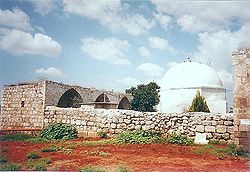Kafr Saba
| Kafr Saba | |
|---|---|

Mausoleum of Nabi Yamin (or Kever Binyamin), with riwaq (prayer hall) to the left.
|
|
| Arabic | كفر سابا |
| Name meaning | the village of Sâba |
| Subdistrict | Tulkarm |
| Coordinates | 32°10′51.52″N 34°56′14.27″E / 32.1809778°N 34.9372972°ECoordinates: 32°10′51.52″N 34°56′14.27″E / 32.1809778°N 34.9372972°E |
| Palestine grid | 144/176 |
| Population | 1,270 (1945) |
| Area | 9,688 dunams 9.6 km² |
| Date of depopulation | 15 May 1948 |
| Cause(s) of depopulation | Military assault by Yishuv forces |
| Current localities | Hak'ramim,Beit Berl, Kfar Saba, Neve Yamin |
Kafr Saba (Arabic: كفر سابا) was a Palestinian Arab village famous for its ancient shrines and for a history stretching back for more than a millennium. The village was depopulated of its Arab residents by Jewish forces on May 13, 1948, one day before the new State of Israel was declared.
Presently the remains of the villages consists of two domed shrines located on either side of Route 55 between Kfar Saba and Qalqiliyya. The larger of the two is called Nabi Yamin, situated on the east side. About 40 meters (44 yd) away, on the west side of the road, is a much smaller shrine named Nabi Serakha. The Nabi Yamin shrine is believed by some Jews to be the tomb of biblical Binyamin/Benjamin and as such, religious Jewish worshipers may be found there.
Around year 985 C.E. Al-Muqaddasi described the place as a large village with a mosque that was situated on the road to Damascus. In 1047 Nasir-i-Khusraw described it as a town on the road to al-Ramla, rich in fig and olive trees.
A five-line inscription recording the grave of Sayf al-Din Bari, dated 1299-1300 CE was recorded within the shrine enclosure in 1922. The present location of this inscription is unknown. A sabil ("water fountain") is situated on the east side of the main enclosure. An inscription embedded on the right side of this sabil referred to the foundation of a fountain for the public by Emir Tankiz, governor of Damascus in 1311-1312 CE.
In 1596, Kafr Saba was part of the Ottoman Empire, nahiya (subdistrict) of Bani Sa'b under the liwa' ("district") of Nablus with a population of 231. It paid taxes on wheat, barley, goats and beehives.
...
Wikipedia

